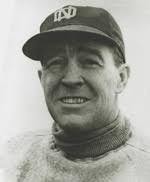 by omahadomer
by omahadomer
Notre Dame conventionally claims 11 national championships: 1924, 1929 and 1930 under Rockne; 1943, 1946, 1947 and 1949 under Leahy; 1966 and 1973 under Ara; 1977 under Devine; and 1988 under Holtz.
Now, there are several years pre-Rockne where ND was also somebody’s national champion: Jesse Harper’s 1913 team was 7-0-0, outscored the opposition 268-41 and clobbered both Army and Texas on the road. There were, however, 5 undefeated and untied teams that year, so who knows.
Harper’s 7-1-0 1915 team is also the national champions of some minor services (that squad lost 20-19 on the road to Nebraska, but crushed everyone else). But there were several undefeated teams that year (including Nebraska and Oklahoma), so this is not a good claim.
Rockne’s 1919 team was 9-0-0 and avenged that Nebraska loss in Lincoln. Again, however, there were other undefeated teams and they played harder schedules.
Rockne’s 1920 team also has a claim as it went 9-0-0 and beat Nebraska in Lincoln, Army, Michigan State, Indiana and Northwestern. Again, however, there were undefeated teams with harder schedules.
So, pre-1924 I’d say that a reasonable claim could be made to all of these years except for 1915 (where ND lost to Nebraska), but because of the relatively easy schedules and the existence of other undefeated teams, it’s hard to make the claim affirmatively.
1924, 1929 and 1930 are all easy: ND was undefeated and had the hardest schedule and beat most of the major competition along the way. In fact, in 1929 because the stadium was being built, the closest ND got to a home game was playing at Soldiers Field.
One minor service makes Rockne’s 1927 team that national champions, but this is a silly claim at that team was 7-1-1.
Now, beginning in 1936, the AP poll came into existence, and it becomes the cleanest way of claiming a national championship, and this is the foundation for ND’s claims thereafter: 1943, 1946, 1947, 1949, 1966, 1973, 1977 and 1988.
Now, the AP poll is probably the best-accepted measure, but it was hardly flawless, particularly before the late 1960’s when it began taking its final poll after the bowl games (the UPI, later ESPN-USA Today coaches poll, actually didn’t shift over until after the 1974 season, hence Alabama’s continued claim to the 1973 championship despite getting beat in the Sugar Bowl by Ara’s Irish).
Now, if we look outside the AP poll for claims to championships in other years post-the creation of the polls, we find claims to national championships in 1938 (Layden’s 8-1-0 team), 1953 (to which I will return below), 1964 (Ara’s 9-1-0 team), 1967 (Ara’s 8-2-0 team), 1970 (Ara’s 10-1-0 team that beat Texas in the Cotton Bowl; Ara was so annoyed at finishing #2 in the AP poll that he asked for and got a revote), 1989 (Holtz’s 12-1-0 team) and 1993 (Holtz’s 11-1-0 team). Now, I’m not going to revisit all of these, but I will point out that under the BCS system, ND would have been the 1989 champion. The championship game that year would have been N.D. and undefeated Colorado. The only effect of the loss to Miami would have been that ND would have worn white and not blue jerseys in the game (much like OU’s loss to KSU in the Big 12 championship game did not keep OU out of the NC game). We, of course, know how that game turned out: 21-6 ND.
Back to 1953. ND that year was 9-0-1. Critically, ND opened the year beating Oklahoma in Norman 28-21. Oklahoma was a fantastic team under Bud Wilkinson. They tied their next contest with Pittsburgh (which ND beat 23-14 two weeks later) but then blew through the rest of their schedule, won the Big 8 and beat Maryland in the Orange Bowl.
The best argument against ND winning the 1953 championship was the 14-14 tie with Iowa (a good team, finished in the top 10). ND actually controlled the game but was mistake prone. ND faked an injury late in the 1st half and the 4th quarter to buy extra time that got them the scores necessary to tie the game. Iowans refer to it as the “Fainting Irish” game. However, this was a common tactic then and the referees could have kept the clock moving, but didn’t. If Iowa was the victim of bad calls, well join the club (yeah, I’m looking at you, the Pac 10 refs). But ultimately you have to go by what was on the scoreboard, which was a tie, and a tie in a game that ND mostly dominated.
So, who’s the competition in 1953? Well, it’s Maryland. Maryland was a very good team, going 10-0-0 in the regular season, but playing southern schools who were sort of in a different universe from ND’s competition. The only common opponent they had in the regular season was North Carolina, which Maryland beat 26-0 at home and ND beat 34-14 on the road, so that would have be adjudged about a draw.
But the critical factor was the bowl game against OU. Maryland lost and ND had beaten OU, on the road, in the regular season. There were no undefeated teams other than ND after the bowls. So if “national championship” in that era means a relatively uncontroversial claim to having actually been the best team on the field, then meet your 1953 national champs: Notre Dame.